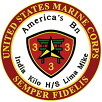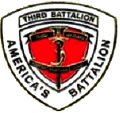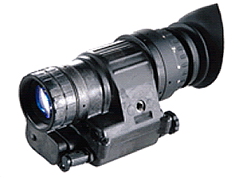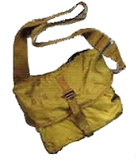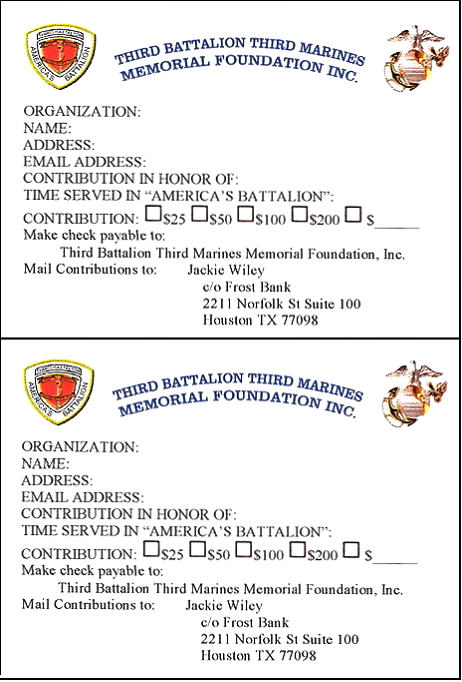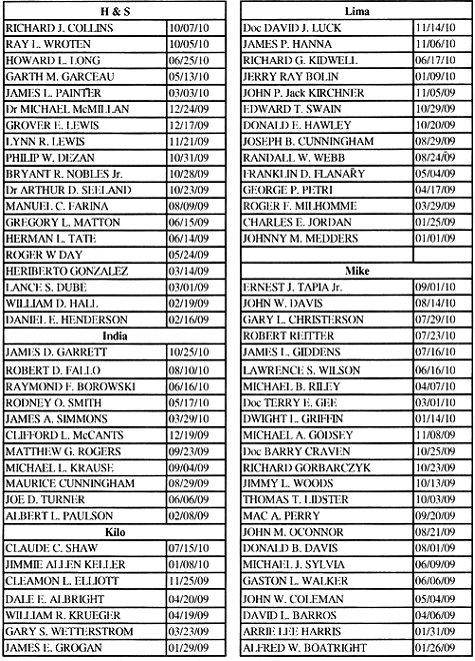Page Title
{Type Your Site Name Here}
{Type a slogan for your site here}
Vol 1
Issue 20
01/01/2011
UNITED STATES MARINE CORPS
BIRTH OF THE UNITED STATES MARINES:
The legacy of the United States Marine Corps was born on November 10, 1775, when Congress commissioned Robert Mullan, the proprietor of Tun Tavern, located on Philadelphia's historic waterfront to raise the first two battalions of Marines, under the leadership of Samuel Nicholas, the first appointed Commandant of the Continental Marines. The U.S. Marines have been the first branch of the armed forces to serve in every war since that day, and have mounted over 300 assaults on foreign shores, from the arctic to the tropics.
ROOTS OF THE MARINE CORPS:
The United States Marine Corps can trace its heritage to the British Royal Marines. Although the current ranks of the Royal Marines number quite small compared to today's US Marines (7,000 vs. 175,000), both Corps of Marines have stood side by side in conflicts around the globe and maintain their close ties. Both Corps of Marines frequently have liaison officers on exchange with each other. The USMC emblem was loosely modeled from the Royal Marines. Neither Corps' emblems incorporates a shield signifying defense, since Marines prefer to be on the offensive and attack the enemy.
During the war of 1812 with England, the British burned nearly every public building in Washington, D.C. (including the White House and the Capital). The Marine Barracks were spared the burning out of respect.
ANCIENT MARINES:
The first documented use of marines as a class of soldier in a standing army belongs to the Greeks and Romans. Themistocles, leader of the Athenians, issued a decree that his navy "enlist Marines, twenty to a ship" to turn back a Persian attack. Rome had special legions of "Milites Classiarri" or "soldiers of the fleet". Roman Marines served through out the remainder of the empire's life, not only at sea but also on land.
CONFEDERATE MARINES:
On 16 March 1861, The Congress of the Confederate States of America established the Confederate States Marine Corps. On 23 May 1861, Col. Lloyd J. Beall, a West Point graduate who resigned his U.S. Army commission to "go south," was appointed as the Colonel-Commandant. Col. Beall served as Colonel-Commandant of the Confederate States Marine Corps until the end of the the American Civil War in 1865.
SEMPER FIDELIS:
The Marine Corps adopted Semper Fidelis as its official motto in 1883 (Semper Fidelis is also the title of the official musical March of the Marine Corps). Translated from Latin, Semper Fidelis means "Always Faithful." U.S. Marines use an abbreviated verbal version, "Semper Fi," to voice loyalty and commitment to their Marine comrades-in-arms. Previous mottos of the Marine Corps were:
(1) "To the Shores of Tripoli," adopted in 1805.
(2) "Fortitude," adopted in 1812.
(3) "From the Halls of Montezuma to the Shores of Tripoli," adopted in 1848.
(4) "By Sea and by Land," adopted in the 1850's.
ONCE A MARINE, ALWAYS A MARINE:
Once a Marine, Always a Marine: This truism was adopted as the official motto of the Marine Corps League. The origin of the statement is credited to a gung-ho Marine Corps Master Sergeant, Paul Woyshner. During a barroom argument he shouted, "Once a Marine, always a Marine!" MSgt. Woyshner was right. Once the title "U.S. Marine" has been earned, it is retained. There are no ex-Marines or former-Marines. There are (1) active duty Marines, (2) retired Marines, (3) reserve Marines, and (4) Marine veterans. Nonetheless, once one has earned the title, he remains a Marine for life.
OFFICIAL BIRTHDAY OF THE USMC:
All U.S. Marines are gung-ho. But, few can match the vision and total commitment of the famous 13th Commandant, General John A. LeJeune. In 1921 he issued Marine Corps Order No. 47, Series 1921.
General LeJeune's order summarized the history, mission, and tradition of the Marine Corps. It further directed that the order be read to all Marines on 10 November of each year to honor the founding of the Marine Corps. Thereafter, 10 November became a unique day for U.S. Marines throughout the world.
Soon, some Marine commands began to not only honor the birthday, but celebrate it. In 1923 the Marine Barracks at Ft. Mifflin, Pennsylvania, staged a formal dance. The Marines at the Washington Navy Yard arranged a mock battle on the parade ground. At Guantanamo Bay, Cuba, the Marine baseball team played a Cuban team and won, 9 to 8.
THE MARINE CORPS BALL:
The first "formal" Birthday Ball took place on Philadelphia in 1925. First class Marine Corps style, all the way. Guests included the Commandant, the Secretary of War (in 1925 it was Secretary of War, not Secretary of Defense), and a host of statesmen and elected officials. Prior to the Ball, General LeJeune unveiled a memorial plaque at Tun Tavern. Then the entourage headed for the Benjamin Franklin Hotel and an evening of festivities and frolicking.
Over the years the annual Birthday Ball grew and grew, taking on a life of its own. In 1952 the Commandant, General Lemuel C. Shepherd, Jr., formalized the cake-cutting ceremony and other traditional observances. For example, Marine Corps policy now mandates that the first piece of cake must be presented to the oldest U.S. Marine present. The second piece goes to the youngest Marine. Among the many such mandates is a solemn reading of the Commandant's birthday message to the Corps.
Like the U.S. Marine Corps itself, the annual Birthday Ball has evolved from simple origins to the polished and professional functions of today. Nonetheless, one thing remains constant, the tenth day of November. This unique holiday for Marine warriors is a day of camaraderie, a day to honor Corps and Country. Throughout the world on 10 November, U.S. Marines celebrate the birth of their Corps -- the most loyal, most feared, most revered, and most professional fighting force the world has ever known.
ABOUT THE U.S. MARINES:
The United States Marine Corps is a force in readiness; always prepared to fight, anywhere, anytime. There is a special aura surrounding the word "Marine." It means something different from a soldier, a cut above, and more can be expected from this person. Pride and cockiness are the trademarks of Marines, the strongest brotherhood in the world. To serve in the Marine Corps is to serve in an organization that demands and delivers excellence beyond all others. Service in the Marines leaves a lasting impression upon the innermost being of everyone who is privileged enough to serve. "Once a Marine, Always a Marine." To dispute this is to invite a brawl.
Marines enjoy a reputation of prowess in battle, that was earned "in every clime and place" throughout the world in our nation's history.
U.S. MARINES THE WORLD'S GREATEST WARRIORS:
Why are U.S. Marines considered the world's premier warriors? What puts the Marine Corps above the rest? Other military services have rigorous training and weapons of equal or greater lethality. So, why do U.S. Marines stand head and shoulders above the crowd?
The truth lies in each person who wants to be a Marine. They did not just join the Marines. They must prove that they are Marines. Many have tried and failed. Only those who survive the crucible of Marine basic training, have been sculpted in mind and body into a Marine. They have become and proven they are Marines.
Once they have earned the title and entered the Brotherhood of Marines, then the new warrior can draw upon the legacy of his Corps. Therein lies their strength. In return, the strength of the Corps lies in the individual Marine. The character (often defined as "what you are in the dark") of these warriors is defined by the three constant Corps Values: honor, courage, and commitment.
THE THREE CORPS VALUES:
Honor, Courage, Commitment. They make up the bedrock of the character of each individual Marine. They are the foundation of the Corps. These three values, handed down from generation to generation, have made U.S. Marines the Warrior Elite. The U.S. Marine Corps: the most respected and revered fighting force on earth.
HONOR: Honor requires each Marine to exemplify the ultimate standard in ethical and moral conduct. Honor is many things; honor requires many things. A U.S. Marine must never lie, never cheat, never steal, but that is not enough. Much more is required. Each Marine must cling to an uncompromising code of personal integrity, accountable for his actions and holding others accountable for theirs. And, above all, honor mandates that a Marine never sully the reputation of the Corps.
COURAGE: Simply stated, courage is honor in action -- and more. Courage is moral strength, the will to heed the inner voice of conscience, the will to do what is right regardless of the conduct of others. It is mental discipline, an adherence to a higher standard. Courage means willingness to take a stand for what is right in spite of adverse consequences. This courage, throughout the history of the Corps, has sustained Marines during the chaos, perils, and hardships of combat. And each day, it enables each Marine to look in the mirror -- and be proud.
COMMITMENT: Total dedication to Corps and Country. Gung-ho Marine teamwork. All for one, one for all. By whatever name or cliché, commitment is a combination of selfless determination and a relentless dedication to excellence. Marines never give up, never give in, never willingly accept second best. Excellence is always the goal. And, when their active duty days are over, Marines remain reserve Marines, retired Marines, or Marine veterans. There is no such thing as an ex-Marine or former-Marine. Once a Marine, always a Marine. Commitment never dies.
U.S. MARINE MASCOT:
Thanks to the German Army, the U.S. Marine Corps has an unofficial mascot. During World War I many German reports had called the attacking Marines "teufel-hunden," meaning Devil-Dogs. Teufel-hunden were the vicious, wild, and ferocious mountain dogs of German Bavarian folklore.
Soon afterward a U.S. Marine recruiting poster depicted a snarling English Bulldog wearing a Marine Corps helmet. Because of the tenacity and demeanor of the breed, the image took root with both the Marines and the public. The Marines soon unofficially adopted the English Bulldog as their mascot.
At the Marine base at Quantico, Virginia, the Marines obtained a registered English Bulldog, King Bulwark. In a formal ceremony on 14 October 1922, Brigadier General Smedley D. Butler signed documents enlisting the bulldog, renamed Jiggs, for the "term of life." Private Jiggs then began his official duties in the U.S. Marine Corps.
A hard-charging Marine, Pvt Jiggs did not remain a private for long. Within three months he was wearing corporal chevrons on his custom-made uniform. On New Years Day 1924, Jiggs was promoted to Sergeant, and in a meteoric rise, he was promoted again -- this time to Sergeant Major -- seven months later.
SgtMaj Jiggs' death on 9 January 1927 was mourned throughout the Corps. His satin-lined coffin lay in state in a hangar at Quantico, surrounded by flowers from hundreds of Corps admirers. He was interred with full military honors.
A replacement was soon on the way. Former heavyweight boxing champion, James J. "Gene" Tunney, who had fought with the Marines in France, donated his English Bulldog. Renamed as Jiggs II, he stepped into the role of his predecessor.
But there was a big problem. No discipline! Jiggs chased people, he bit people. He showed a total lack of respect for authority.
The new Jiggs would have likely made an outstanding combat Marine, but barracks life did not suit him. After one of his many rampages, he died of heat exhaustion in 1928. Nonetheless, other bulldogs followed. During the 1930s, 1940s, and early 1950s they were all named Smedley, a tribute to General Smedley Butler.
In the late 1950s the Marine Barracks in Washington, the oldest post in the Corps, became the new home for the Corps' mascot. Renamed Chesty to honor the legendary Lieutenant General Lewis B. "Chesty" Puller, Jr., the mascot made his first formal public appearance at the Evening Parade on 5 July 1957. In his canine Dress Blues, Chesty became an immediate media darling, a smash hit.
After the demise of the original Chesty, the replacement was named Chesty II. He became an instant renegade. You name it, he did it. He even escaped and went AWOL once. Two days later he was returned in a police paddy wagon. About the only thing he ever managed to do correctly was to sire a replacement.
In contrast to his father, Chesty III proved to be a model Marine. He even became a favorite of neighborhood children, for which he was awarded a Good Conduct Medal. Other bulldogs would follow Chesty III (bulldogs don't live long). When Chesty VI died after an Evening Parade, a Marine detachment in Tennessee called Washington. Their local bulldog mascot, Lance Corporal Bodacious Little, was standing by for orders to Washington.
Upon arrival at the Marine Barracks in Washington, Lance Corporal Little got ceremoniously renamed Chesty VII. He and the English Bulldogs who followed him epitomize the fighting spirit of the U.S. Marines. Tough, muscular, aggressive, fearless, and often arrogant, they are the ultimate canine warriors.
English Bulldogs. "Teufel-hunden." "Devil Dogs." They symbolize the ethos of the Warrior Culture of the U.S. Marines.
HAPPY BIRTHDAY MARINES!
3/3 Active Duty
PATROL BASE JAKER, Afghanistan –
A memorial service honoring the life of 1st Lt. Scott J. Fleming
took place at Patrol BaseJaker, Afghanistan, Sept. 25. He was
remembered for his selflessness and leadership.
Fleming, a platoon commander with Company K, 3rd Battalion, 3rd Marine Regiment, died in support of combat operations in Helmand province, Afghanistan, 9/17/2010.
“Anyone who was close to Lt. Fleming knew the Marines of his platoon came first, and it was easy to see how much he cared for them,” 2nd Lt. David Rooks said during the memorial. “Lt. Fleming was a Marine whose personality cannot be replaced and whose leadership will be missed.”
During the service, Fleming’s fellow Marines highlighted his passion for his work. Afghan leadership honored his sacrifice.
“Fleming’s life was given for the freedom of Afghanistan and the people of Nawa, and this will never be forgotten by the people of Nawa,” said Nawa District governor Haji Abdul Manaf.
Fleming’s Marines spoke of his positive influence on them.
“As a Marine officer and friend, he made a big impact on our lives,” said Sgt. Jorge Diaz, a squad leader with Kilo Company. “He died doing something he cared about.”
Fleming is survived by his wife and parents. His awards include the Purple Heart Medal, Combat Action Ribbon, National Defense Service Medal, Afghanistan Campaign Medal, Global War on Terrorism Service Medal, Sea Service Deployment Ribbon, and the NATO Medal. He is interred at Arlington National Cemetery. Fleming requested this privilege in his will.
_____________________________________________________________
3/3 has been deployed for 6 months, at this writing, and
should be arriving back at K-Bay by the end of
November. The advanced party is already home.
Unfortunately, this will be in print before I get a full
update. I’ll attempt a tour synopsis in the next issue.
17 September 1969
By Bob Durand L/3/3 1969
I was a Lance Corporal serving in third platoon, Lima 3/3, Third Marine Division, at the time. Before we set in for the night, we went on a patrol, down near the river below hill 154. Hill 154 was an anonymous hill in the Razorback Valley, about six clicks south of the DMZ and four and a half clicks NNW of The Rockpile. While on that patrol, our point element spotted a couple of NVA running into the jungle, but it was decided not to pursue them as it was getting late and we needed to get up the hill and dig in for the night. Also, it was a favorite tactic of the NVA to let a couple of their soldiers be seen, knowing we'd chase them, and draw us into an ambush they had set up, so we let them go.
When we set up for the night, my squad was set up in our fighting holes overlooking the Cam Lo River on the north side of the company perimeter. There were four people in my fighting hole, with one person on watch and the rest sleeping. When the shooting started, around 0100, I was asleep, wrapped up in my poncho. I woke up and immediately grabbed my M-16, helmet, magazines, frags, and flak jacket, then headed down to the hole as I was sleeping on the hill about ten feet above our fighting hole. It was a wet, cold, foggy, miserable night. We received small arms, machine gun, chicoms and RPG fire. The odd thing, I thought, was that for the entire night we were never on the receiving end of enemy artillery or mortar fire.
I soon realized that my military issue, glass-lens eyeglasses were cracked and broken. It must have happened when I grabbed my gear. So, under fire, I crawled back up to my pack and retrieved my extra pair of glasses. I figured we were in for a long night, and I didn’t want to be half blind to boot. It turned out to be a long, sleepless night, just one of many during my 13-month tour of duty.
We received artillery support and flares from a nearby firebase, probably The Rockpile (Payable) or Vandergrift FSB. Artillery support was very good and was called in all night, 'danger close' in many instances. The flares, on a dark, foggy night, are very eerie! The sound of the canisters spinning to the ground as the flares swung back and forth hanging from their parachutes caused the shadows to sway from side to side. This makes it appear that everything you look at is moving. This can be very confusing and it is an experience one never forgets. Since we were fogged in, we received no air support, nor could choppers get in to medevac the dead and wounded until the next morning.
At about 0200 there was a large explosion about thirty meters to my right. Sappers had thrown a satchel charge almost right on top of one of our fighting holes (I was later told that the Marines in the hole were smoking and that gave away their position). That was when our perimeter was breached. The NVA soldiers rushed in and took over one or two of our fighting holes.
They started yelling, “Corpsman up!” Not knowing it was a trap, our Corpsman, ran to help. They riddled him with AK-47 fire. A squad from third platoon was outside the perimeter on an ambush and was recalled. I believed they helped, along with other marines on the perimeter, to retake the holes from the NVA. The next morning, I helped load “Doc Scotty” on the med-evac chopper. We had no body bags, so we loaded him and about fifteen other KIAs on to the CH-46 wrapped in ponchos. There were at least fifteen entrance wounds in Doc Scotty’s body. We also found five NVA bodies about twenty feet in front of our fighting hole. We had taken them out with a claymore.
At some point in the night a member of my fire team was wounded by a piece of shrapnel which hit him on the side of his face. He crawled up the CP to get it fixed up, and then he returned to the perimeter. However, he was put in a fighting hole about ten meters behind my hole, sort of a second line of defense. I still had his weapon and ammo, so I crawled up to his new hole to give it to him. On the way back, a piece of shrapnel from an RPG hit me in my leg. It wasn’t too bad, and I just pulled it out and returned to the fight. I never reported it as there were no Corpsmen left and everyone else was busy trying to stay alive. A few days later, the company was pulled out of the bush and sent to Quang Tri as Third Marines were being pulled out of Vietnam. By this time my leg had become infected. I was treated for the infection there, and eventually went back to 'the bush' as I stayed in country and finished my tour with India 3/7, 1st MarDiv.
1st Lt. James P. Rigoulot reported that the battle area was littered with pieces of enemy weapons and body parts. "One machine-gun-hole had 13 gooks stacked up in front of it," Rigoulot said. "That gun probably saved us from being overrun, they were right on us. The area was literally infested with them."
[Note: This info is from the 3/3 Command Chronology]
In the end there were 64 NVA KIA, 13 USMC KIA, 3 USN KIA, 23 USMC WIA and 1 USN WIA. Captured were 2 RPDs, 1 RPG2, 1 RPG7, 10 AK 47s, 1 RPG7 sight, 1 unexploded satchel charge, 76 Chicom grenades, and 124 filled AK47 magazines.]
START MAKING YOUR PLANS
3/3 Reunion BRANSON MO
Jul 30 - Aug 5, 2012
120 S Wildwood Drive, Branson, MO 65616
Reservations: 1-888-566-5290
(or 417-335-5767)
(hotel link will be available online around 12/01/10)
Be sure to provide group code: 3/3 RVN
Rooms:
$104/nite STD or
$139/nite Leisure Suite (+ taxes)
Mail in your Reunion Registration/Activity forms
(mailing out approx Aug-Sep 2011)
REUNION PLANNING:
With the size of our reunions, a ton of planning takes place over the two years between gatherings. Much of this is crucial based on how many will attend. We are conducting a poll to assist in getting an idea of how many will attend, and other basic info. We need to know the following …
We are looking at chartering the Branson Belle show boat for our banquet … The approximate all-inclusive cost of $85-$95. This does include the bus ride to the Branson Belle dinner, program, and a full stage show (not just the meal). Please respond by mail or phone.
Please respond by Jan 15, 2011 via this link: IF you are planning on attending:
(Note: This is for planning only and does not register you for the reunion.)
ACCOMODATIONS AVAILABLE:
Standard rooms
$104+tx
Leisure Suites
$139+tx
A 2 room suite featuring bedroom with a king size bed and living area with a queen size sleeper sofa plus a large work desk and easy chair with ottoman
Living area featuring a dining area for 4 complete with table, chairs and small refrigerator
Adjoining bathroom features an enclosed closet, spacious whirlpool tub and walk-in shower
Each Leisure Suite features a living area with walk-out balcony so guests can enjoy views of Branson
Starlight Nightscope
By Dan Price
This is my understanding/memory of how 3/3 was given one of the prototype Starlight Scopes. Of the two prototype scopes sent to Viet Nam the Army kept one and the other was given to Gen. Lewis Walt by Gen. Wm. Westmoreland. Gen. Walt sent the scope to 3/3 where it was assigned to S-2 Scout Ron Spratley who picked me to work with him. Cpl. Spratley and I received the scope on 4Jul66.
We were in a compound on the west side of Hill 327. We were given a molded plastic case containing the scope, two "D" cell batteries, a mount to a M-14 on bi-pod with automatic selector and about three or four pages of mimeograph instructions. We put things together and learned to "prime" the scope so by darkness we could see thru the lens and get an idea of how it worked. The instructions told of sighting in the rifle during daylight. We could not see thru the scope in the daylight.
It took about two days of spare time work going over the instructions before we finally understood we had to leave the objective (forward) lens cap in place to see thru the scope in the daylight. The scope had what we called a Lieutenants bar instead of crosshairs. Since the Lieutenants bar was not centered and instructions not clear it always showed in the upper left quadrant so point of impact became the lower right corner of the bar. Sighting in was a pretty straight forward project and we were ready for duty.
We were given a Willey Peter grenade to take care of the scope if we got in an uncontrolled situation. To prime the scope required putting flesh over each end of the scope and holding the toggle switch to one side for something like 30 seconds. Not enough time and you got to start over. For a bean pole L/Cpl. to do this required a right bicep on the rear lens and a thigh on the forward lens. Cpl. Spratley was plenty big enough to just use biceps.
We started by doing perimeter duty around 3/3 base but were soon being sent to different companies needing some help with "active" perimeters. We would travel by 6x6 or chopper and spend one or more nights at different locations. Good duty but I often did not know where we were.
The Starlight scope works on a light gathering system as opposed to the heat detection of the infrared scope. When anything more than a slight amount of light was visible to the scope it would obliterate the vision. Flares of any kind and even our own tracer rounds would obliterate the scope and force us to shut the scope off, wait for a short period (seems like a minute or so) of time, start and reprime the scope and try to find the target again. This was a really unhandy feature.
We would have several different magazines set up for different applications. A magazine with only ball ammo would be just for us firing or when we wanted some backup we would have a magazine with five or six ball ammo and then some tracer rounds to help nearby squads acquire target sites. We also had a magazine with all tracer rounds for target identification for the whole world but we would have no scope view after about the second tracer was fired. This made participation difficult when things got heated.
Since the rifle had to be sighted in after being cased for movement in 6x6 or chopper or being taken off for day patrols it was important that the adjustments worked. The sight adjustment worked for about three weeks before becoming inoperative. That was the point we turned the scope back in and resumed our Scouting duties, whatever they were.
In reflection I wish we could have done more good with night harassment and night ambushes and saved more of our brothers from whatever fate. I guess all of us have had those wishes!
It is my understanding that many present duty Marines are familiar with the modern Starlight scope. It would be interesting to know about improvements and current uses.
Ron Spratley says pictures were taken on Hill 22. One picture of the M-14 with the scope mounted, one of me on the Starlight and one of Spratley in the distance.
AN/PVS-1 Night Vision Sight “Starlight Scope”
(1st Generation) used on M14 Rifle (circa 1965-70)
(photo of actual scope used unavailable at press time)
Type: Passive “starlight” scope intensifying ambient light
Weight: [estimated] 8 pounds complete with battery
Effective range: same as with conventional sights
The “Starlight scope” has been through many evolutions since originating in Germany in the late 1930’s.
In current use is the PVS-14/6015 model night vision pocket scope , which is the preferred current generation US military night vision scope. This scope uses current head mounts and is weapons adaptable.
From Doc’s bag-o-tricks
We were treated at least like semi-humans.
We had classes in pharmacology, bandages, and anatomy, and INJECTIONS… (No oranges for practice …we used each other!) triage, burns, wounds…. on and on. This on top of the regular barracks and personnel inspections (we were always 4.0). You could shave in the mirror-like polish on our barrack's tile floor!
Our Company Nurse was LtCdr. Munoz. A nice lady, but a bit shy, considering she had to put up with our antics! We had a dummy for classes; the Nurses called it George. During a class on T-Binder bandages, the dummy was wheeled to the front of the class, always covered by a sheet.
Miss Munoz was called away from the room for a few minutes, and George was replaced with a black guy who name just happened to be named George. Munoz, came back in, continued her lecture, never once looking down at the sheet covering the “dummy”. Every time she said the name “George”, in referring to the actual dummy, there were stifled chuckles from the class and the sheet would start jiggling. She never noticed it!
Eventually she reached down, and after holding the corner of the sheet for what seemed like an eternity, as she came to the proper moment in her presentation, she whipped the sheet off, looked down at this grinning black guy! She jumped straight back about four feet propping herself against the wall, gasped, turned pale, started unbuttoning the top buttons of her uniform blouse.
“You shouldn’t do this to me,” she exclaimed, “I have a heart condition!”
Well, it was funny for a split second, but then the guilty feeling set in for having frightened her so badly ... she was truly revered by us, and we didn’t want to lose her. There were no more of that type of shenanigans with Miss Munoz.
However, …
Our sister company’s nurse was a LtCdr Steinacher. The name was appropriate. She took no guff from anyone! In fairness, she was a great instructor, but was a bit on the terse side.
When we had the Intra-Muscular injections class, she wound up being our instructor for some reason, but I believe it was so Miss Munoz would not get any surprises like the one a few days earlier with “George”.
She asked for “volunteers” to be her subject in the demo. Several hands went up, which she ignored, probably being savvy through years of dealing with these crafty Corpsmen-in-the-making. She pointed at one guy, and "volunteered" him. He laid butt-up on the table, and she covered him partially with a sheet. He lowered his trousers under it as she continued her lecture.
Now he is on his belly, with his face toward the class, grinning from ear to ear! She finally got to the point of doing the injection, carefully folds the sheet back to expose a butt cheek, stares unbelievingly for a moment….
She is looking at a tattoo of a skunk! The class roared!
I'm pretty certain that she was less than delicate giving that injection….
Revenge is mine, sayeth the Nurse!
I turned 20 years old midway through “A” School. I believe I graduated 16th in a class of 42. Now I am officially a Hospital Corpsman. Look out world!
Three years later I would turn 23 at Con Thien in Vietnam. Funny how it was so long ago, but seems like only yesterday ...
May 6th 1966… Hospital Corps School San Diego
I took boot camp leave, two weeks… and then it was off to Balboa Naval Hospital in San Diego, arriving on May 9th, 1966 for 15 weeks of Hospital Corpsman “A” School. While this was a step up from boot camp, and there were still a lot of formations, marching, etc., it was a little more laid back.
Third Battalion, Third Marines Memorial Foundation
This is a project that deserves your attention, and needs your support … both physically and financially.
This is proposed to be a 9 foot tall bronze sculpture with a footprint of 4’x4’ on the base, and placed in Semper Fidelis Memorial Park adjacent to the Marine Corps Museum at Quantico. It features 3/3 Marines from all eras … WWII to current. There are 3 figures around the center … WWII-Korea, Vietnam, and recent duty, with emblems of each era.
The proposed design is on the following page, although some modifications may be incorporated prior to casting.
The approximate cost will be $250,000. 10% of that goal is met currently.
Donations small and large are needed to bring this to fruition.
Consider that forgoing one cigarette per day, or one soda/beer/drink per week and donating that savings to the Memorial … $50 over the course of a year ... would complete the goal in short order, with participation by all hands. Send $5 per month if necessary.
Corporate donors would boost the project too. If you know of a business that would contribute, by all means make the effort to contact them.
All donations are tax deductible. The Foundation is a 501c19 chartered veterans group. The board is comprised of 3/3 alumni of all eras.
Spread the word! Make sure your buddies are aware of this and that they get involved.
A pledge form is on page 18. You can copy it and make copies to distribute to others.
2010 Reunion Books available at cost:
[only 150 left … this is a limited edition]
36 pages full color … heavy weight paper
Includes 3/3 history and 3/3 Memorial Wall
Approximately 200+ pictures
$10 per book (includes mailing cost)
3/3 Reunion Book , PO Box 33, Gentry AR 72734
